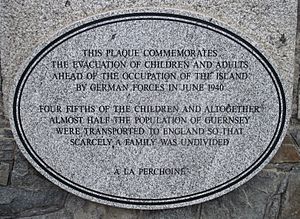St Julian's Pier
St Julian's Pier is a long structure built into the water in Saint Peter Port Harbour, Guernsey. It stretches out from the land, helping boats to dock and providing a place for people to walk and enjoy the views.
The pier begins where St Julian's Avenue meets the coast. From there, it extends eastwards into the harbour. Other parts of the harbour, like the Cambridge Berth and the New Jetty, were built later. These sections extend south from the main pier. At the very end of the pier is the White Rock Pier.
To the north of St Julian's Pier, you will find the Queen Elizabeth II marina. This is a special area where many boats are kept safely in the water.
Discovering St Julian's Pier
St Julian's Pier is not just a place for boats; it's also home to several important monuments and memorials. These structures help us remember key moments and people from Guernsey's history.
Remembering Important Events
The pier features several special places that tell stories of the past:
- A large obelisk and sundial mark the 50th anniversary of Guernsey's liberation. This celebrates the island becoming free again after a difficult time.
- The Liberation Stone also reminds everyone of this important freedom day.
- There is a plaque that remembers the children and adults who had to leave Guernsey in June 1940. They were evacuated to England to stay safe before the island was occupied by German forces. Almost half of Guernsey's population left, meaning many families were separated.

- A plaque honours the victims of the Holocaust. This remembers the many people who suffered greatly during World War II.
- Another plaque remembers the Deportees. These were people from Guernsey who were forced to leave their homes during the war.
- The Harbour Bombing Memorial remembers a sad event when the harbour was bombed.
- A plaque remembers the Foreign Workers. These were people brought to the island during the occupation.
- The Guernsey Resistance plaque honours those who bravely resisted the occupation.
These monuments and plaques help us learn about the island's past and remember the strength and resilience of its people.

